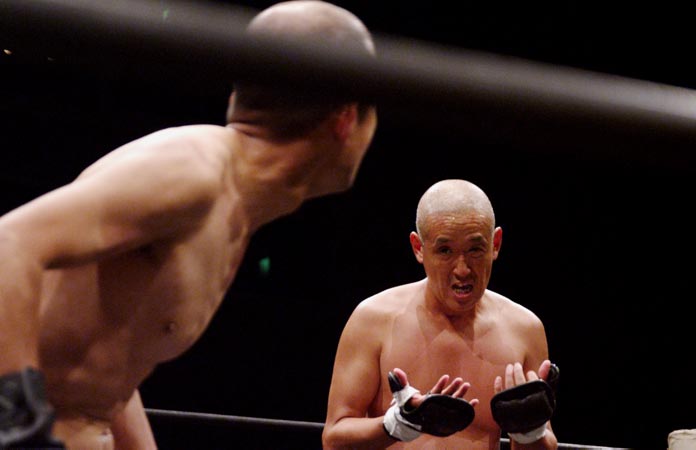Movie Review: Doglegs
Published on June 29th, 2016 in: Current Faves, Documentaries, Matshifter, Movie Reviews, Movies, Pro Wrestling, Reviews |
Doglegs co-founder, and star of the film, Shintaro Yano (ring name “Sambo” Shintaro) strikes a fighting pose. © Alfie Goodrich
Japanese wrestling or “puroresu” is a tradition that goes back to the 1950s, and is most closely associated with a more realistic, hard-hitting “strong style” than we normally see in Western pro wrestling, which is far more choreographed. Strikes usually land for real, though the intention is still primarily to put on a show, not actually hurt one’s opponent. The style is tough on the performers, and those that thrive in the competitive landscape of “puro” are considered some of the best and most resilient wrestlers in the business. Still, the style is often hard to watch, given what we know now about concussions and other injuries that can be commonplace in puro.
You can imagine, then, how hard it is to watch a puro match, not between able-bodied athletes in peak physical condition, but with disabled wrestlers. Heath Cozens’ Doglegs, a documentary about an eponymous group of mostly disabled Japanese wrestlers, is certainly difficult to sit through, but is ultimately worthwhile for its ability to wring triumph from tragedy.
The story of Doglegs is told primarily from the perspective of Shintaro, one of the group’s only remaining original members. He’s the group’s hero, a wrestler with autism in the last days of his career. With an ever-present smile and jocular nature, it’s easy to root for Shintaro. As he looks back on his remarkable, 20-year career and the lead up to his final match, Shintaro is shown at his job as a cleaner, attending a women’s wrestling show featuring one of his former schoolmates, and in other locations around Tokyo. It makes for a powerful contrast as his normal life is intercut with the violent wrestling matches in which he partakes.
The relationship between Mr. and Mrs. L’Amant, also wrestlers in Doglegs, is bizarre enough for its own film. L’Amant, “The Lover,” is a cross-dressing alcoholic with extremely severe cerebral palsy. His wife, known only by the moniker of “Mrs. L’Amant,” is his able-bodied caregiver who wrestles her husband with her arms and legs restrained in order to be on more of an equal playing field. The L’Amants have a tragic fatalism hanging over them, with Mr. L’Amant frequently saying that he’ll drink himself to death and that he’ll die in the ring. When the two wrestle each other in Doglegs, it seems there’s some catharsis for the powerfully-framed but diminutive Mrs. L’Amant, which is a triumph of a sort.

Sambo Shintaro and Kitajama (right). © Paul Leeming
The most pervasive ethos of Doglegs the film (and the organization) is to avoid presenting Shintaro and the other competitors as pitiable figures. Though the majority of our dialogue about the disabled typically focuses on (and stops at) “care,” the fringe wrestling organization takes an unpopular (or at least rarely-expressed) view that a “tough love” approach to the disabled can be a path to empowerment. Whether or not this is actually the case is a different story.
Shintaro’s non-disabled rival, Kitajima, is brutal with him, both physically and emotionally. He beats the crap out of Shintaro in their matches, and calls him a loser both in front of, and away from, the audience. It’s hard for me to see how this is in any way helpful to Shintaro specifically, and it appears as though Kitajima takes a perverse pleasure in it, even suggesting at one point that there’s a sexual element here. As with the L’Amants, there’s something unsettling just under the surface.
As a directorial effort, Cozens’ film weaves footage spanning over 20 years and together with shockingly honest interviews to create as cohesive a story as you can expect from such strange subject matter. While Shintaro’s story doesn’t go exactly where you’d expect, Cozens allows him and his fellow disabled wrestlers to celebrate their uniqueness, however that manifests itself. There’s nothing cheap or exploitative about the presentation of the matches or in interviews, though Cozens doesn’t shy away from making every hit feel nearly as brutal for the viewer as it does for the competitors.
As you can tell from any previous reviews I’ve written, I try not to shy away from the experience of a film that’s difficult to watch, and Doglegs is no different. When I watch these disabled men and women fighting each other, even in a “fake” pro wrestling context, it’s undeniably hard to divorce it from the idea that these people are necessarily being exploited. But in examining that feeling, I can’t help but think there’s paternalism at work there. Who am I to pass judgement on these people for wanting to push themselves like any other athlete?
Though Doglegs (the organization) has problematic elements, like the use of a non-disabled person in Kitajima as the antagonist, when you see the wrestlers experience the kind of glory normally reserved for sports stars in ESPN’s 30 for 30 documentaries, there’s something undeniably positive about that. If there’s a worthy successor to 2005’s Murderball, this may be it.
Doglegs is out on various VOD platforms, including iTunes, Amazon, Vudu, and Xbox Live on June 28.
Time limit is exhausted. Please reload the CAPTCHA.